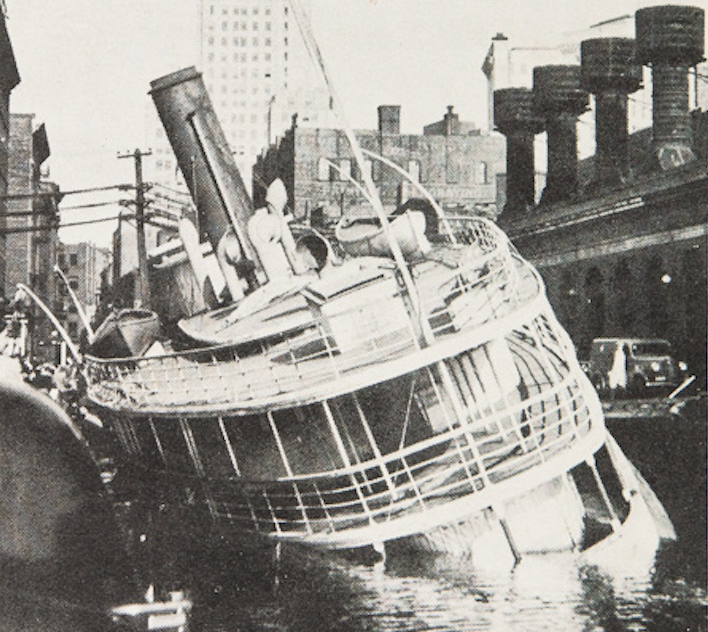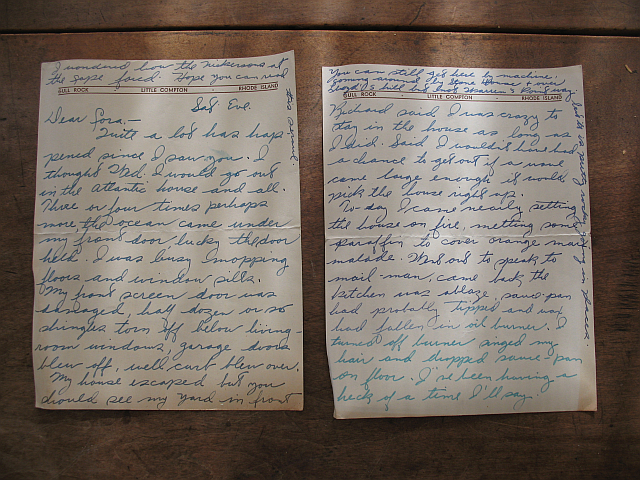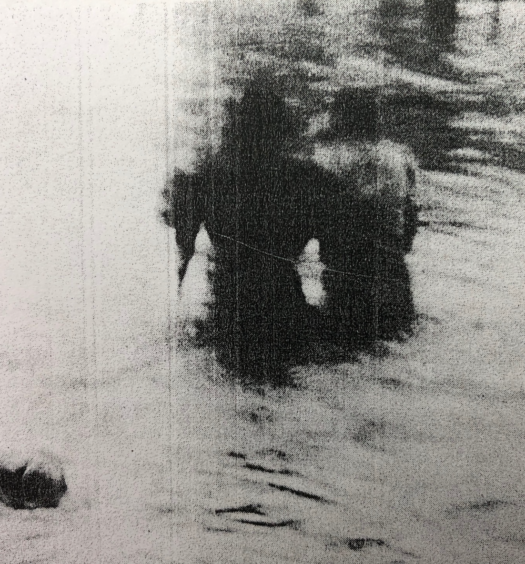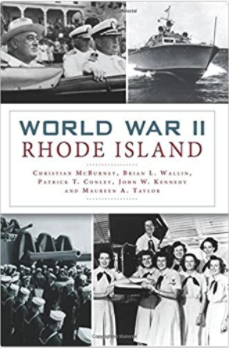In the summer of 2012, I took on the task of organizing and arranging the library and archive at the Western Rhode Island Civic Historical Society, located in the Paine House Museum in Coventry. I sought some advice on how best to proceed from Kirsten Hammerstrom, who was at that time the Director of Collections at Rhode Island Historical, and Patricia Ahl, Museum Assistant and Archivist at the Pettaquamscutt Historical Society (now known as the South County History Center). They both emphasized my first endeavor should be to remove the newspapers from the other documents and papers, then catalog them and store the newspapers separately from the rest of the collection. This is because, starting in the mid-19th century, wood pulp replaced rag linen as the raw material used for newspaper manufacture. Wood pulp paper produced before the 1980s, when exposed to moisture in the air, generates sulfuric acid. The newsprint from the aging newspapers can be very destructive to other documents should they come in contact with each other. The Western Rhode Island Civic Historical Society had a lot of newspapers mixed in with the rest of their collection, and it took me a good part of that summer to separate and catalog the newspapers.
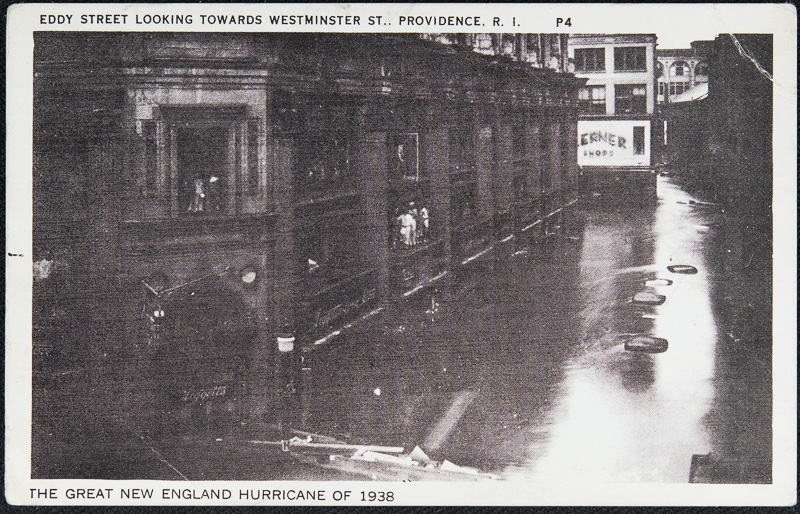
Eddy Street looking towards Westminster Street in Providence shortly after the Hurricane of 1938 (Providence Public Library Digital Collections)
One August afternoon, I took yet another bundle of newspapers from a stack of other materials and carried them over to the work table. These particular newspapers were inside a deteriorating paper bag and tied with string. On the outside of the bag were written the words: “The Story of the Hurricane of 1938.” I was intrigued.
The newspapers, all copies of the Providence Journal, the Providence Evening Bulletin or the Providence Sunday Journal, ranged in date from September 22, 1938 (the day after the 1938 Hurricane struck) to October 9, 1938. For the first few days the headlines were all related to the storm: “Hurricane Kills At Least 125 In State” on September 22; “71 Dead, 57 Missing in Westerly…Villages Vanish; Coast Changed” on the 23rd; “Toll of Hurricane Reaches 300” on September 24. But a few days after the disaster, alongside the reports of the storm damage and the cleanup were stories of an escalating crisis and the possibility of war in Europe. The Czechs were balking at Hitler’s demand for the Sudetenland on September 27th, 1938, but over the next several days “The Big Four” weighed in, appeasing Hitler and trading the Sudetenland (and in the spring of 1939, the rest of Czechoslovakia) for eleven more months of peace. For October 3, 1938, the headlines read “Sudetens Welcome Hitler.” The world was moving in an unsettling direction.
Meanwhile, Rhode Island continued with its clean-up efforts. On September 28, sharing the headline with “Hitler Agrees to 4-Power Talks,” was “One Giant WPA Plan to Clear State Charted.”
Then, as I took each paper and cataloged it, I discovered, in the midst of “The Story of the Hurricane of 1938” collection, a folded letter with a letterhead identifying its origin as from Little Compton. Along with the letter was a small square of white paper, on which is stamped, “Town of Wareham Selectman’s Office September 30[?] 1938.” Written next to the official stamp is, “Pass to Onset Edward Tourtellot and Party of Four. Officer Reidy.”
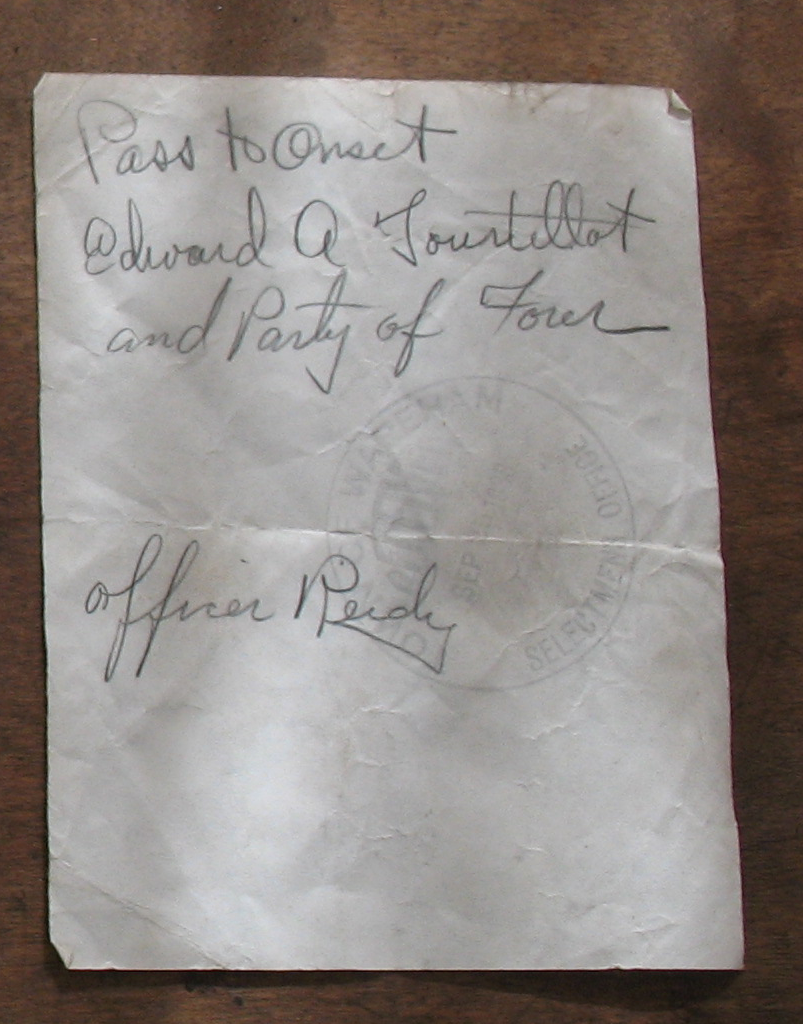
Officer Reidy’s pass to visit Onset, Massachusetts after the hurricane struck there (Western Rhode Island Civic Historical Society Archives)
Onset, I discovered, is a village (and a beach) in Wareham, Massachusetts. Onset Bay lies off the coast of Wareham and opens up to Buzzards Bay and out to Rhode Island Sound (Onset is labeled B on the map). Wareham is at the exact opposite end of the stretch of coastline that begins with Little Compton (labeled A on the map). From Little Compton the coastline curves east and north until it reaches the isthmus of Cape Cod, opposite the Elizabeth Islands and the western block of Cape Cod. In a hurricane storm surge, the coastline and islands would funnel the storm waters in Buzzard’s Bay higher and higher until they reach the end of the funnel. There lies Onset.
The letterhead on the paper the letter is written upon has printed in a neat maroon font:
GULL ROCK – LITTLE COMPTON – RHODE ISLAND
The letter itself reads:
Sat. Eve.
Dear Fora [Sara?],
Quite a lot has happened since I saw you. I thought Wed. [Sept. 21] I would go out in the Atlantic house and all. Three or four times perhaps more, the ocean came under my front door, lucky the door held. I was busy mopping floors and window sills. My front screen door was damaged, half dozen or so shingles torn off below living-room windows, garage doors blew off, well curb blew over.
My house escaped but you should see my yard in front [page 2] sand and rocks. bayberry bushes. bathing house door, large rocks brought up right to my front door. Moved those large boulders I had for a wall half way across the front lawn.
If you came down now you wouldn’t see any Warren’s Point bathing beach or “break-water.” All houses down and from breakwater. Big fishing bldg went floating up the river with 3 people or more in it. several drowned. Two houses next Stone House collapsed.
I had 2 suit-cases packed and planed [sic] to move up to Lowe-Smith’s [Love-Smith’s?] if I had to get out. [page 3] Richard said I was crazy to stay in the house as long as I did. Said I wouldn’t have had a chance to get out if a wave came large enough it would pick the house right up.
To-day I came nearly setting the house on fire, melting some paraffin to cover orange marmalade. Went out to speak to mail-man, came back the kitchen was ablaze, sauce-pan had probably tipped and wax had fallen in oil burner. I turned off burner singed my hair and dropped sauce pan on floor. I’ve been having a heck of a time I’ll say.
[page 4] coming down Wed. nite Richard had to jump from his car just below Stone Bridge [in Tiverton]. He took the road near the water thinking there would be trees falling on the highland road. A large wave came and turned the car over. He was up to his waist in water. Left the car there. The wreckers brought it down the next nite. I don’t think its any good now. It had floated down the river some distance from where he abandoned it.
Yesterday his riding-horse was taken sick. We went for veterinary said sleeping-sickness so he had to be shot. This is all I can write now as I want to write my cousin in Middleboro[?] whose sister lives in Wareham also hard hit
Eliz.
[in the top and side margins on page 1]
I wondered how the Nickersons at the cape[?] fared. Hope you can read this scrawl.
[in the top and side margins on page 2]
You can still get here by machine, coming around by Stone House & over Lloyd’s hill but not Warren’s Point way but it is pretty rocky going in places.
[end of letter]
Based on the evidence in the letter, Elizabeth had probably gone to her “Atlantic house” on Wednesday September 21, 1938, without knowing that a Category 3 hurricane was bearing down on the coast. She was familiar enough with Richard that he was most likely a relative of Elizabeth — a cousin, son or brother, or even possibly her husband. Conditions were still so bad Wednesday evening that Richard’s car was rolled over by a wave while he was driving to Gull Rock. Both were fortunate not to have been swept away in the storm.
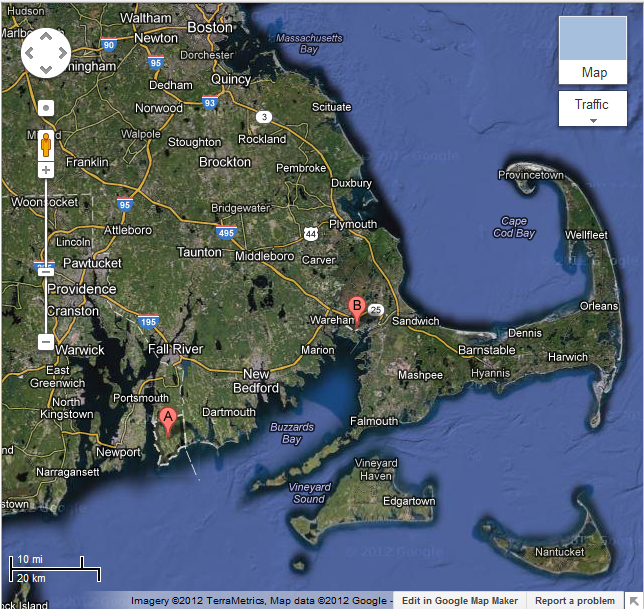
Map of southeastern New England showing the locations of Little Compton, Rhode Island (A) and Onset, Massachusetts (B)
My father, born in a farm house on Metacom Avenue in Bristol in 1925, had related similar stories of his experiences in the 1938 Hurricane to me since I was a kid. He turned thirteen in 1938 and was living in Fishtown, which was once a village outside of Mystic, Connecticut (there seems to be little left of Fishtown at present beyond its old cemetery).
The day the ’38 Hurricane struck, my father recalled, school let out a bit early once the teacher realized a bad storm was brewing. Before he got home, the water flooding the road to Fishtown was up to the front sprocket of his bicycle and he was pedaling in a foot and half of water. A passing delivery truck stopped and the driver yelled to my father, “Get in!” The driver threw my father’s bike into the back of his truck, and delivered him safely home.
Then the storm really hit. The old farm house, built in 1721, weathered the storm with only some minor damage, but my father, my grandparents and my Uncle Walt (my grandmother as it happened was also very pregnant with my Uncle Bruce in September 1938) looked on as the wind blew the roofs off two barns, and then tore both barns off their foundations and rolled them across the yard.
I attempted to locate “Gull Rock” on maps of Little Compton, including one from 1925 that the Little Compton Historical Society has “zoomified” on its website, but neither that map nor any others I have looked at has a location marked Gull Rock. Based on Elizabeth’s descriptions, it was probably not far from the beach since waves reached to her front door and rolled her stone wall around. There are other clues in her letter too — Stone Bridge, for instance, and Lloyd’s Hill, that might help piece together where in Little Compton Elizabeth and Richard weathered what has been described as the worst hurricane to strike New England since the Great Colonial Hurricane of 1635. Elizabeth’s letter, dated only “Sat. Eve.,” was probably written on Saturday September 24, 1938, and the pass from the Wareham selectman, appears to be dated September 30, which was the following Friday. Likely there is a connection between the reference to Wareham in Elizabeth’s letter and the document from the selectman’s office — had they heard from Elizabeth’s cousin or her cousin’s sister? Conditions in Onset were bad enough that selectmen had apparently closed off access to the area to those without a pass. And speaking of the selectman’s pass, why is this with the letter sent from Little Compton? Was Fora (or Sara) one of the “party of four” led by Edward Tourtellot that traveled to Onset on that late September day? Who bundled together these newspapers, the letter and the pass and eventually donated these items to the Western Rhode Island Civic Historical Society for posterity?
Altogether, there may be enough information in these documents to eventually identify who Elizabeth and Richard were. The one clue that would have identified the those involved — the envelope the letter was mailed in — was not with the letter or in the bundle of newspapers.
In any event, here is another story about survival and human perseverance during a tremendous disaster. Having grown up listening to many a tale of this mighty storm, it is a significant reality of Rhode Island history that the only living witnesses to the ’38 hurricane are all in their eighties or older now. If anyone reading this is a living eyewitness to the Hurricane of 1938, or knows of someone who is, or who has an interesting story that has been passed down to them about the storm — and wishes to record an oral history for posterity — please contact the author at wrichs.archive@gmail.com.
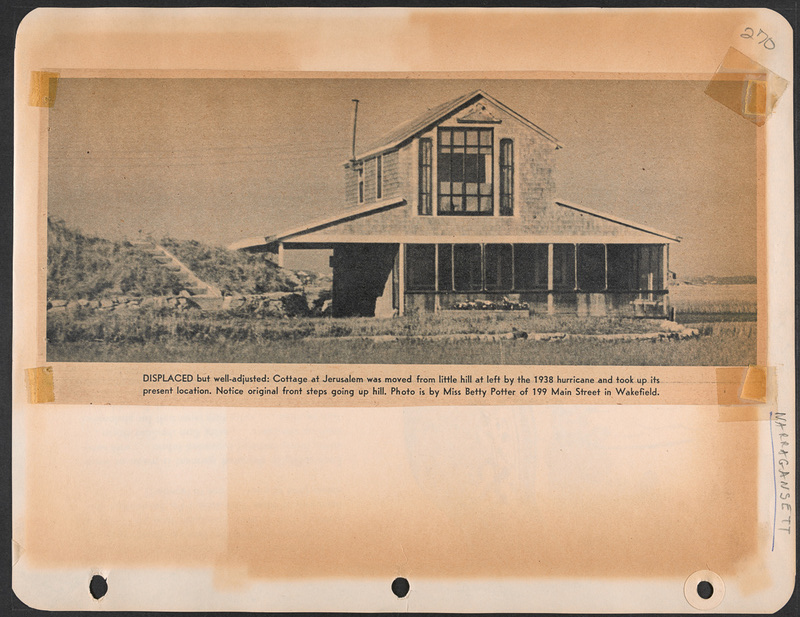
“Cottage was moved from little hill at left by the 1938 hurricane and took up its present location. Notice original front steps going up hill. Photo is by Miss Betty Potter of 199 Main Street in Wakefield.” (From unidentified newspaper, Providence Public Library Digital Collections)
[This article is an edited version of an article posted on September 1, 2012 on the author’s blog, originally entitled “Adventures in Archiving: A Letter From Gull Rock.” Another version of the original blog post also appeared in the September and October 2012 issues of The Hinterlander, the monthly newsletter of the Western Rhode Island Civic Historical Society.]
[To read three more articles on the Hurricane of 1938, click on the Archives tab and type in the search box the term hurricane.]
[Banner image: Steamer sunk at pier in Providence from the Hurricane of 1938 (Providence Public Library Digital Collection)]

